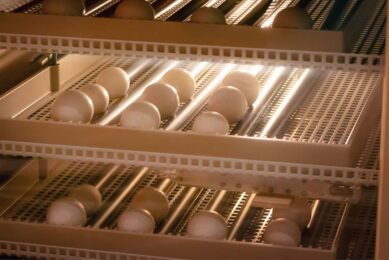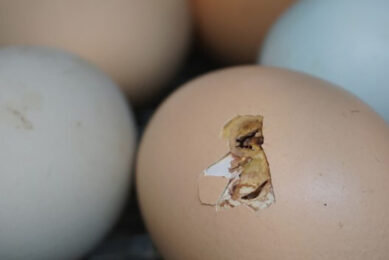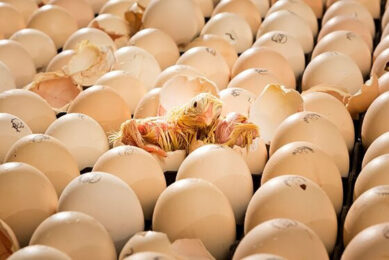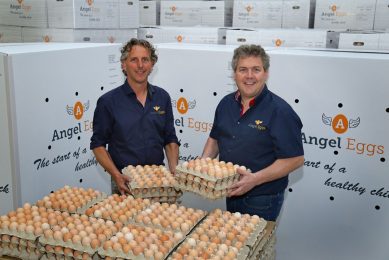Pre-incubation to improve hatchability
![Negative effects of long egg storage on hatchability can be reduced by pre-incubating the eggs. [Photo: Ton Kastermans]](https://www.poultryworld.net/app/uploads/2021/04/001_618_rb-image-1788498-848x565.jpeg)
Even under optimal ?conditions, beyond one week of storage the hatchability of eggs will drop 0.5 – 1.5% per day with the percentage increasing as storage extends further. After two weeks of storage, the chick quality will also be impaired. Pre-incubation is one tool to reduce the negative effects of long egg storage.
Pre-Incubation will not and cannot improve hatchability, but helps to maintain it over longer periods of time (see Figure 1 below). Therefore it starts making sense using this technique, if eggs are scheduled for a storage period which leads to a noticeable decline in hatchability. The gains made depend on the local conditions of the flock and the storage. Improper cooling after pre-incubation might cause negligible or even negative improvement.
Learning from mother hen
A hen needs approximately 24 hours to produce an egg. Around 30 minutes after an egg is laid the next follicle is ovulated. The follicle falls into the infundibulum where the fertilisation takes place. After that the albumen is added, the egg membranes are formed and the egg shell is composed.
Therefore the eggs arriving at the hatchery contain an embryo representing already 23.5 hours development in the hen’s body. However this developmental stage at point of lay is not optimal for long storage. In nature it would be altered by periodical warming of the eggs during the time the hen sits on the nest to produce the next egg of the clutch. In the hatchery it is possible to achieve similar results by incubating the eggs for 3 to 6 hours during the first storage days. This leads to further development of the germinal disk to a stage containing 60000 – 80000 cells. At this stage the embryo is less susceptible to cell death occurring during the storage period.
How does pre-incubation work?
The aim is to apply 3 to 6 hours of incubation during the first days of storage. These hours mean the time the eggs spend in 100°F/37.8°C incubation temperature. In order to bring the eggs to this temperature the eggs need to be heated-up and they also need to cool down afterwards. The different steps of the total pre-incubation procedure are shown underneath.
| Pre-incubation steps
The optimal day to pre-incubate the eggs depends on the pick-up frequency and the transport conditions. While treating the eggs soon after lay gives best results one should not forget to give hatching eggs a rest after long transport and/or traying (to do the treatment eggs need to be placed on setter trays).
While pre-warming of the eggs is not necessary when single-stage incubators are used for the treatment, it can facilitate the process. Many hatcheries use the pre-warming or delayed-start function of the incubator to set the eggs at a time which suits the staff.
The heat-up time depends on the heating capacity of the incubator and the number of eggs set. If it takes longer than 9 hours to heat-up the eggs the number of eggs should be reduced for the next treatment. The shorter the heat-up time the longer is the recommend pre-incubation time, because the effective time for embryo development during the heating-up phase is shorter. Most hatcheries work successfully with 3-4 hours on incubation temperature. Heat-up time plus pre-incubation time should not exceed 12 hours.
Ideally eggs are cooled down below 25°C before they are moved back in the egg room in order to avoid warming of remaining eggs in the storage room. This cooling can be done in the incubator or in the setter room.
Pre-incubation will do no harm to eggs which are set soon after the treatment. If eggs are scheduled for more than 10 days storage after the treatment it can be beneficial to do a second pre-incubation one week after the first one. If pre-incubated eggs are going to be set, the necessary incubation time is shorter than normal. The usual incubation time can be reduced by approx. 6-8 hours (compare to figure 2: time of egg temperature >32°C). Rule of thumb: If a hatchery treats all eggs scheduled for long egg storage, it can use the same setting time for all eggs. This makes life easier as usually long stored eggs would need an earlier setting time. |
 Beheer
Beheer








 WP Admin
WP Admin  Bewerk bericht
Bewerk bericht